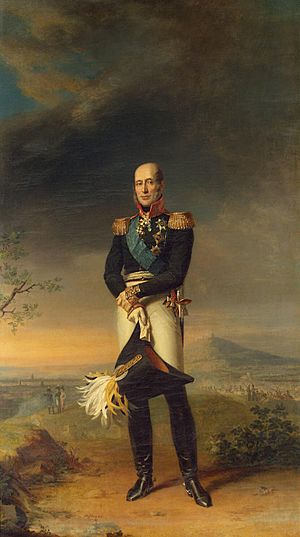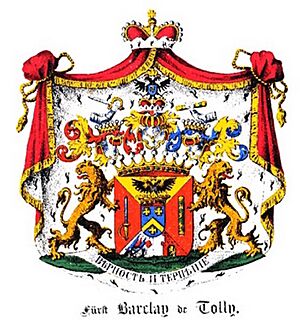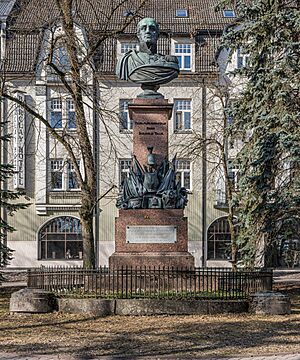Michael Andreas Barclay de Tolly facts for kids
Quick facts for kids
Field Marshal His Serene Highness
Prince Michael Andreas Barclay de Tolly
|
|
|---|---|

Portrait by George Dawe
|
|
| Other name(s) | Mikhail Bogdanovich Barclay de Tolly |
| Born | December 1761 Pomautsch, Polish–Lithuanian Commonwealth (present-day Pamūšis, Šiauliai County, Lithuania) |
| Died | 24 September [O.S. 12 September] 1818 (aged 56) Insterburg, Kingdom of Prussia (present-day Chernyakhovsk, Kaliningrad Oblast, Russia) |
| Buried | |
| Allegiance | |
| Service/ |
Imperial Russian Army |
| Years of service | 1776–1818 |
| Rank | Field Marshal |
| Commands held | Governor-General of Finland Minister of War |
| Battles/wars | Russo-Turkish War (1787–1792)
Russo-Swedish War (1788–1790)
|
| Awards | See § Awards and decorations |
Prince Michael Andreas Barclay de Tolly (born December 1761 – died May 1818) was a very important Field Marshal in the Russian Empire. He is best known for his role in the Napoleonic Wars, especially when Napoleon invaded Russia in 1812.
Barclay came from a Baltic German family in Livland. His father was the first in their family to become part of the Russian nobility. Michael joined the Imperial Russian Army when he was young, in 1776. He showed great skill and bravery in several wars, including the Russo-Turkish War (1787–92), the Russo-Swedish War (1788–90), and the Kościuszko Uprising in 1794.
In 1806, Barclay started fighting in the Napoleonic Wars. He was wounded in the Battle of Eylau in 1807 while helping the Russian army retreat. After recovering, he led successful missions in the Finnish War against Sweden. He even led troops across the frozen Gulf of Bothnia during a snowstorm! Because of his achievements, he became the Governor-General of the Grand Duchy of Finland. From 1810 to 1812, he served as the Minister of War for the Russian Empire.
Contents
Early Life and Military Beginnings
Michael Andreas was born in December 1761 in a place called Pamūšis, which is now in Lithuania. He grew up in Jõgeveste, in Livonia. His family, the Barclay de Tollys, were German-speaking people with Scottish roots. Their ancestor had moved to Livonia from Scotland.
Michael's grandfather was the mayor of Riga, and his father served in the Russian army. Michael himself started his military career in 1776. He was raised by his aunt in St. Petersburg, which helped him learn about higher society. He had two brothers who also served in the Russian army.
A Brave Soldier: Early Wars

Barclay joined the Pskov Carabineer Regiment in 1776. By 1778, he was a cornet, a junior officer rank. He fought in the Russo-Turkish War (1787–92) and showed great courage during the capture of Ochakov. For this, he received a special award.
In 1789, he moved to the Finnish front during the Russo-Swedish War. A few years later, in 1794, he fought in the Kościuszko Uprising in Poland and was honored for helping capture Vilnius. By 1794, he was a lieutenant colonel. He quickly rose through the ranks, becoming a major general in 1799.
In 1806, he fought against Napoleon. He was wounded at the Battle of Eylau in 1807, but his bravery earned him a promotion to lieutenant general. After recovering, he led troops in the Finnish War in 1808. He famously marched his army over the frozen Gulf of Bothnia to surprise the enemy. This amazing feat made him a full general and Governor-General of Finland. A year later, he became the Minister of War.
Facing Napoleon: The 1812 Invasion
When Napoleon invaded Russia in 1812, Barclay de Tolly was in charge of the 1st Army of the West, which was the largest Russian army. He decided to use a strategy called "scorched earth". This meant retreating and burning everything behind them, so the French army would have no food or supplies.
This strategy made him unpopular with many Russians. They thought he was a coward because he kept retreating. After the Battle of Smolensk, where the French were not stopped, Tsar Alexander I appointed Mikhail Kutuzov as the new commander-in-chief. However, Barclay still led the 1st Army.
Kutuzov continued Barclay's "scorched earth" retreat. Barclay bravely commanded the right side of the Russian army at the Battle of Borodino. After Napoleon's army was forced to retreat from Russia, Barclay's tactics were seen as brilliant. He became a hero to the Russian people.
Leading the Russian Army to Victory
After Napoleon's defeat in Russia, Barclay de Tolly returned to lead the Russian forces. He fought in the German Campaign of 1813 and the French Campaign of 1814. These campaigns helped end the War of the Sixth Coalition.
After Kutuzov died, Barclay became commander-in-chief again in 1813. He led the Russian army in major battles like Bautzen, Dresden, Kulm, and Leipzig. For his excellent leadership at Leipzig, the Tsar made him a count.
In 1814, Barclay led the Russian army into France and helped capture Paris. For this huge victory, he was made a Field Marshal. In 1815, he commanded the Russian army that occupied France after Napoleon's final defeat. He was then given the title of prince.
His health began to decline, and he left the military. He died in 1818 while traveling to Germany.
His Lasting Legacy
Barclay de Tolly's body was embalmed and placed in a special Mausoleum in Jõgeveste, Estonia. This mausoleum was built in 1832.
Today, there are many monuments to honor him. A large statue stands in front of the Kazan Cathedral in St. Petersburg, Russia. There are also statues and busts in Riga, Chernyakhovsk, and Tartu.
For a long time, some historians didn't give him enough credit because he wasn't ethnically Russian. But now, his leadership and strategies are highly praised. Even an asteroid, 4524 Barklajdetolli, is named after him!
Awards and Honors
Barclay de Tolly received many important awards for his bravery and leadership. Some of his top honors include:
- Order of St. Andrew (Russia's highest award)
- Order of St. George (Russia's highest military award, he received all four classes)
- Gold Sword for Bravery (a special sword with diamonds)
- Order of St. Vladimir
- Order of St. Alexander Nevsky
- Order of St. Anna
- Order of the Black Eagle (from Prussia)
- Military Order of Maria Theresa (from Austria)
- Legion of Honour (from France)
- Order of the Bath (from the United Kingdom)
- Military William Order (from the Netherlands)
|
See also
 In Spanish: Mijaíl Barclay de Tolly para niños
In Spanish: Mijaíl Barclay de Tolly para niños





